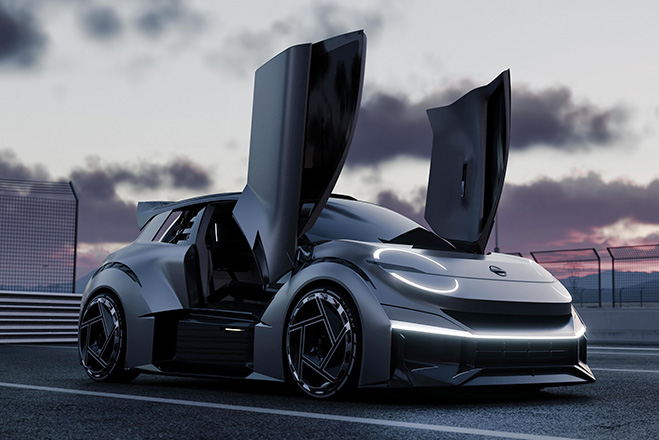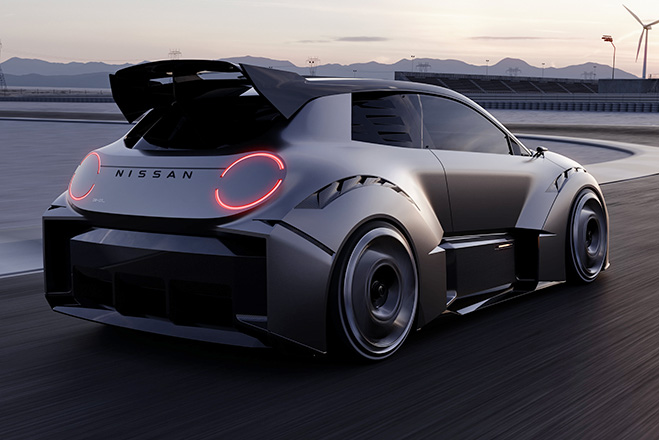
Nissan presents the Concept 20-23 show car
To celebrate the 20th anniversary of London-based Nissan Design Europe (NDE), Makoto Uchida, President and CEO of Nissan, visited NDE to unveil a new sporty urban electric concept car: the Nissan Concept 20‑23.
The 20-23 concept was displayed at the entrance to NDE, on a barge moored in Paddington Basin, a body of water that forms part of the Grand Union Canal, characteristic of the charming and inspiring area where the Japanese design studio is based in London. the brand is located.
Nissan Concept 20‑23
The Nissan Concept 20-23 was the work of a team of junior NDE employees who were tasked with developing a model without restrictions that they wanted to use for urban commuting.
The name Concept 20-23 refers to the 20th anniversary of NDE's presence in central London, as well as the numbers 2 (ni) and 3 (san), which in Japanese are pronounced the same as the brand name, and, of course, the current year. The car also follows Nissan's long tradition of creating hatchbacks and city cars that are pleasing to the eye. Another reference to the brand's heritage is the Pike series, that is, small cars Nissan Be-1, Pao, Figaro and S-Cargo. The Concept 20‑23 is just such a car, but created for the 21st century.
Alfonso Albaisa, Senior Vice President, Global Design, Nissan Motor Co Ltd.who was present at the London presentation of the Concept 20‑23 model, said:
“The young designers at NDE were given simple instructions: to design a beautiful electric city car that they would like to drive around London every day. Their Concept 20-23 is a compact hatchback clearly inspired by online racing. I really like how this car combines elements of modern city living, online gaming and zero-emission mobility.”
The modern style of this small and friendly car reflects the atmosphere of online racing and Nissan's participation in Formula E. The three-door hatchback shape of the Concept 20‑23 has been enriched with extreme aerodynamic additions at the front and rear. including highly shaped spoilers that channel air away from the front of the car, brake cooling slots and vents behind the rear wheels.
The front of the car is a flat panel that flows smoothly into the hood and gives the whole thing an extremely minimalist look. The headlights are located inside the panel, their expressive shape is emphasized by narrow upper and lower semicircles and a sharp LED strip. The turn signal is part of a semicircular LED module.
The shape of the headlights gives the Concept 20-23 a beautiful appearance, despite the complexity of the shape due to aerodynamics. On the side of the car, the muscular wheel arches attract attention, under which large rims with low-profile tires can be seen. Ventilation slits at the top of the front and rear wheel arches reduce pressure that can build up in the wheel well.
The curve of the wheel arches ends abruptly at the lower edge of the doors, where sloping lines border the air intake behind the front wheel. Slots like these in the rear wheel arches help cool the rear brakes. Under the sills, of course, there are side spoilers.
At the rear, a harmonious continuation of the roof rails is a large one-piece spoiler with almost vertical tips on the C-pillars, which merge into a horizontal panel that provides the body with sufficient downforce. The roof spoiler does not restrict visibility to the rear, as is the case in many sports cars with a similar element.
The taillights, similar in style to the headlights, also feature narrow lower and upper LED half-circles that contrast with the boxier, function-oriented lower bodywork. Its shape is determined by the need to obtain maximum downforce at the point where the air exits from under the car. A horizontal stripe, reminiscent of a gentle smile, defines the aesthetics of the rear and at the same time optically widens the body.
The narrow air intake is located in the roof of the car, where it connects to the upper edge of the windshield and provides ventilation for dynamic driving of the Nissan Concept 20-23.
The gray body paint has an interesting texture that gives the impression of machined metal and looks great in the harsh conditions in which the car will be used. On the reverse side the company number 23 is located 3/4 of the way up.
Although the Concept 20‑23 is conceived as an exterior model, the interior design team has developed interior trim elements that harmonize with the extremely sporty exterior design. First of all, the car is equipped with two doors that open upward and are installed at the base of the A-pillar.
The edges of the door opening are lined with foam to protect the driver and passenger's elbows when entering. Two deep bucket seats provide good torso support without sacrificing comfort. They have off-white upholstery and large headrests similar to those found in racing cars.
In front of the driver is a rectangular sports steering wheel mounted on a long column, with numerous buttons and other elements that control the functions of the car. The transmission control levers and several additional switches are at hand.
The steering column is encased in a carbon fiber bracket, bolted to the base of the large open well that forms the center console.
Between the driver and passenger are two metal beams that hold the console in place and are attached to a visible longitudinal member in the floor, forming the "spine" of the car. A fire extinguisher was installed under the stiffening beams.
The interior is thus a futuristic interpretation of a racing car, subordinated to functionality. Multiple screens display only the most important information to maximize driver distraction - just like real Nissan Formula E racing cars or their virtual counterparts in online simulators.
Alfonso Albaisa He summed up the Concept 20-23 project as follows: “This is a fitting way to celebrate 20 years of Nissan Design Europe, where bold ideas take shape and come to life!”
Source: Nissan










